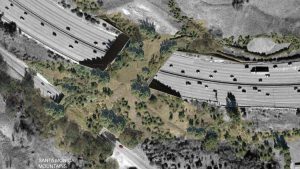From The Los Angeles Times, Sept. 2, 2015
Caltrans proposes wildlife overpass on 101 Freeway
By Martha Groves
 Mountain lions, bobcats and other wildlife would have less chance of becoming roadkill if the state adopts a plan to build a landscaped bridge over the 101 Freeway in Agoura Hills, supporters of the proposal said Wednesday.
Mountain lions, bobcats and other wildlife would have less chance of becoming roadkill if the state adopts a plan to build a landscaped bridge over the 101 Freeway in Agoura Hills, supporters of the proposal said Wednesday.
State agencies, elected officials and wildlife advocates urged the state to provide the much-needed link in an area where rampant development and highways have fragmented once-continuous habitat. The 165-foot-wide, 200-foot-long overpass near Liberty Canyon Road would connect the Santa Monica Mountains on the south with the Simi Hills and Santa Susana Mountains.
Large carnivores in particular have found the 101 to be a formidable barrier. Since National Park Service biologists began researching mountain lions in the Santa Monica Mountains in 2002, motorists have struck and killed a dozen of the big cats in the study area, including a male puma hit on the 101 near Liberty Canyon two years ago.
12 Amazing Animal Bridges Around the World
Animals bridges, which may also be known as ecoducts or wildlife crossings, are structures that allow animals to safely cross human-made barriers like highways. A wildlife crossing is the broadest term and can include: underpass tunnels, viaducts, overpasses and bridges, amphibian tunnels, fish ladders, culvets and green roofs.
Wildlife crossings are a practice in habitat conservation, allowing connections or reconnections between habitats and combating habitat fragmentation. They also assist in avoiding collisions between vehicles and animals, which in addition to killing or injuring wildlife may cause injury to humans and property damage. It has been reported that vehicle-animals collisions costs the United States a staggering $8 Billion a year.
The first wildlife crossings were constructed in France during the 1950s. European countries including the Netherlands, Switzerland, Germany, and France have been using various crossing structures to reduce the conflict between wildlife and roads for several decades and use a variety of overpasses and underpasses to protect and reestablish wildlife such as: amphibians, badgers, ungulates, invertebrates, and other small mammals. [Source: Wikipedia]
The Humane Society of the United States reports that the more than 600 tunnels installed under major and minor roads in the Netherlands have helped to substantially increase population levels of the endangered European Badger. The longest “ecoduct” viaduct, near Crailo in the Netherlands, runs 800 meters and spans a highway, railway and golf course. [Source: Wikipedia]
